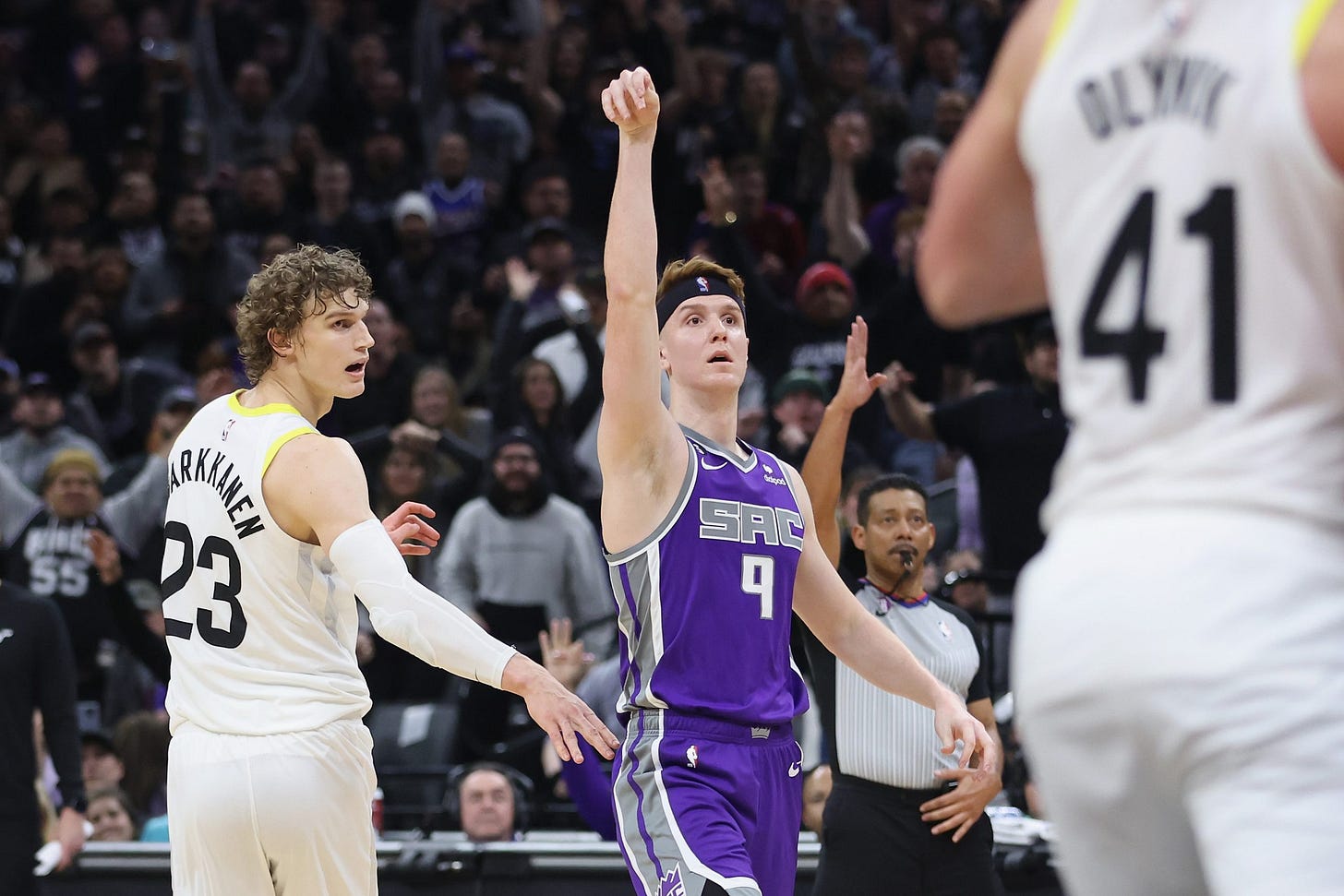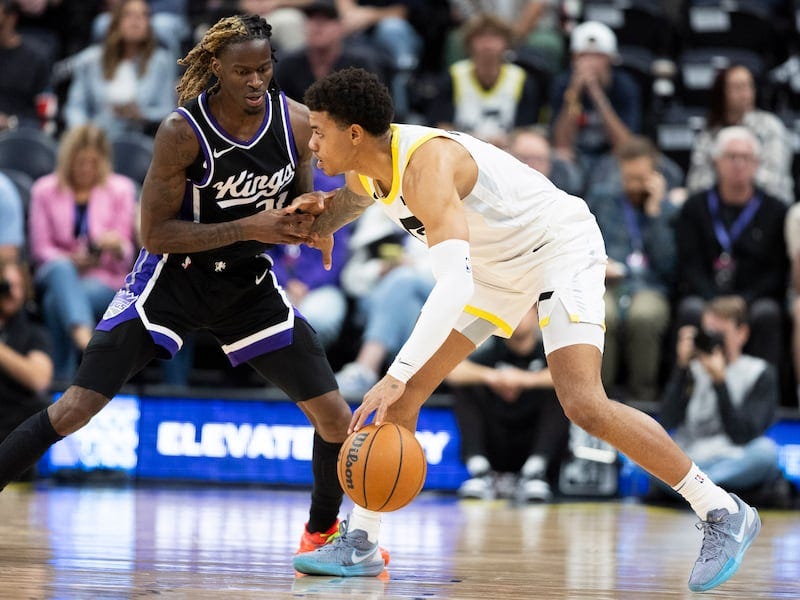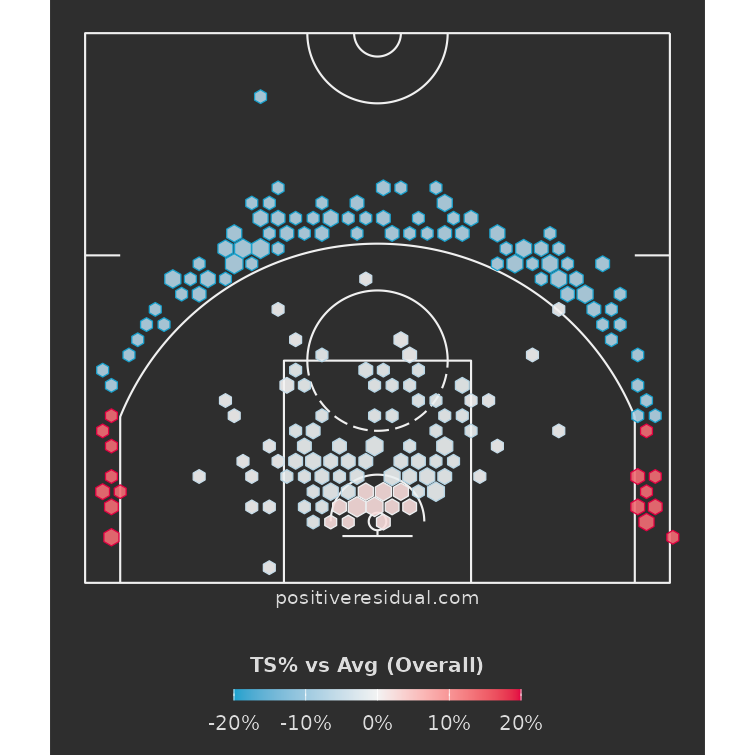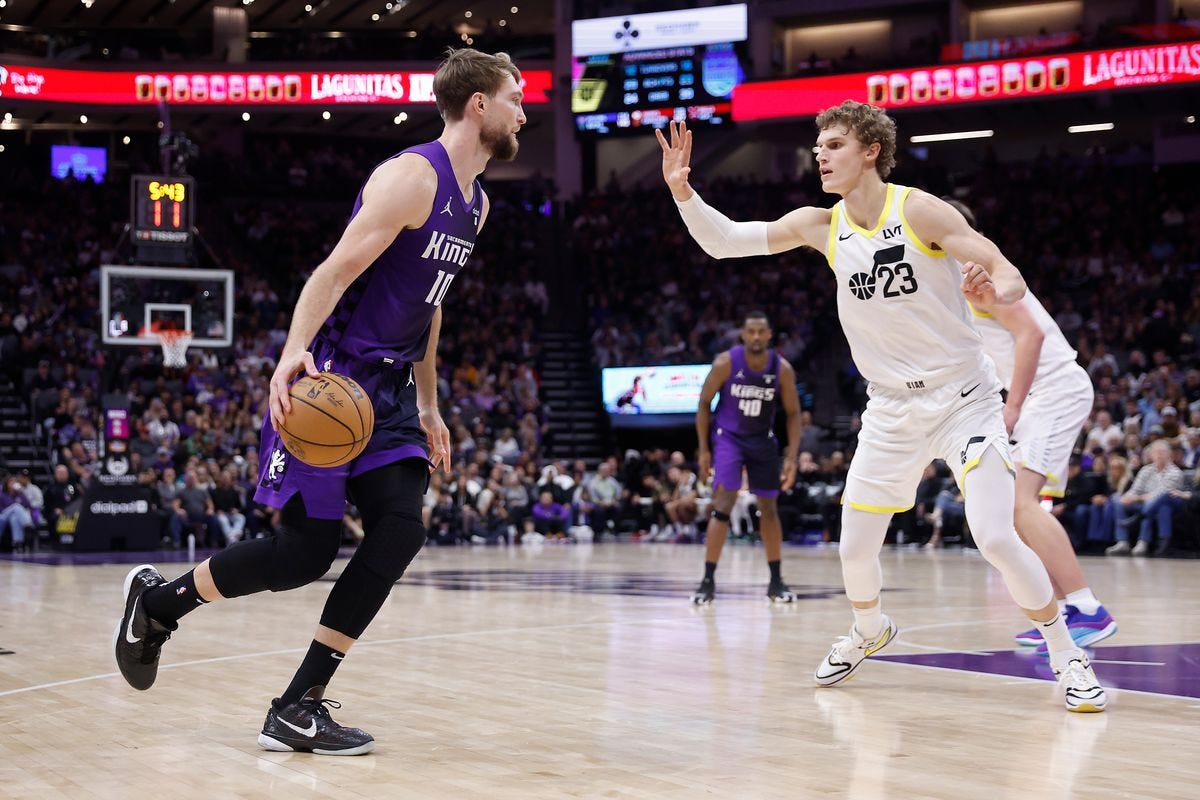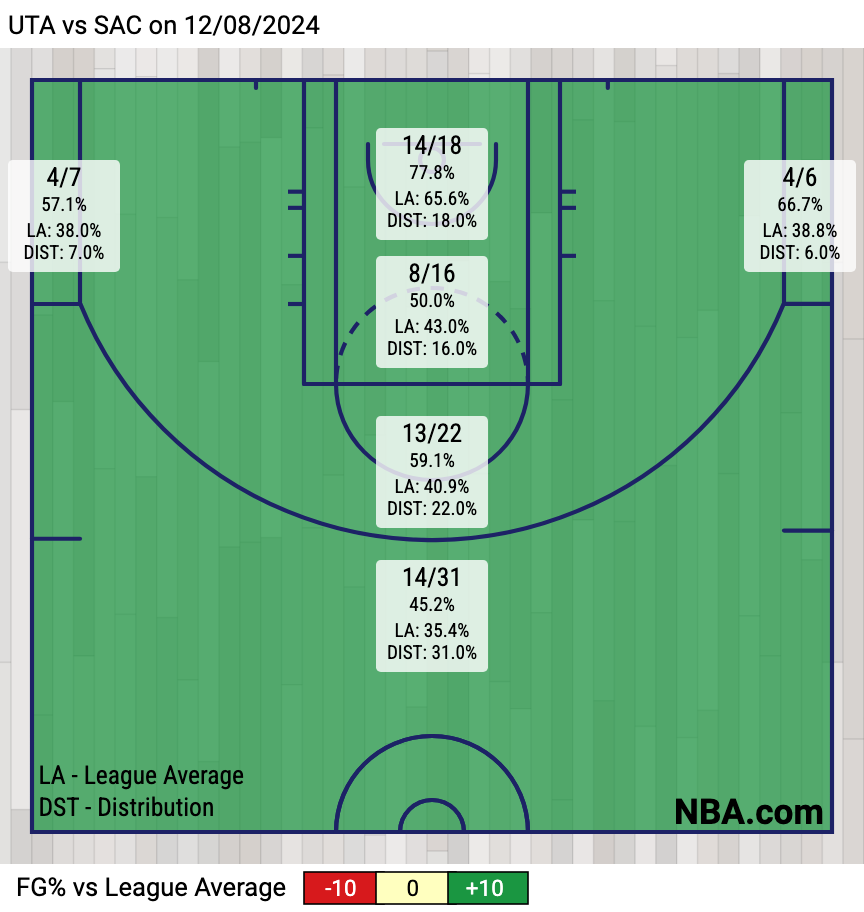12/8 Utah Jazz vs Sacramento Kings Recap
Keyonte George’s Efficient Scoring Run and Utah’s Defensive Struggles Against Sacramento
The Utah Jazz fell to the Sacramento Kings just 48 hours after their dominant win over the Portland Trail Blazers. Sacramento showcased a stellar offensive performance, scoring 141 points and placing six players in double figures, including Kevin Huerter, Domantas Sabonis, Malik Monk, DeMar DeRozan, and Doug McDermott. For the Jazz, scoring inside the arc was a significant challenge, though they shot reasonably well from beyond it. Lauri Markkanen struggled mightily, managing only 8 points, a performance that makes it almost impossible for Utah to compete effectively. Alongside Markkanen’s off night, much of the second unit underperformed, compounding the team’s issues. However, not all was bleak for the Jazz—Keyonte George emerged as a bright spot, delivering an efficient and promising performance.
In this edition of Swish Lake City, we’ll take a closer look at Keyonte George’s standout game, analyzing what he did well and exploring the potential glimpses it offers into his future.
Keyonte George’s Efficient Scoring Stretch
Over the Utah Jazz’s last three games against the Thunder, Blazers, and Kings, Keyonte George has averaged an impressive 19.3 points and 5.0 assists per game while posting a 64.5% True Shooting percentage. What’s particularly surprising about this stretch is that George has only shot 33.3% from beyond the arc—a respectable but far from standout figure. Instead, his success has come from other areas, including improved scoring inside the arc, which has been a notable weakness earlier in the season. Additionally, George has started to get to the free throw line more consistently, further contributing to his efficient scoring.
Examining Keyonte George’s shot chart for the season reveals a mixed performance in the paint. He has a 49.0% True Shooting percentage in the paint, slightly below the league average by 1%, but a strong 71% in the restricted area, which is 2% above the
league average. While these numbers are respectable, what stands out is George’s ability to attack the paint, as 28% of his shot attempts come from this area—8% higher than the league average. In Sunday night’s game, George took full advantage of Sacramento’s lack of rim protection, consistently finding success inside the paint and scoring with ease.
A recurring theme for the Utah Jazz this season has been their lack of pace, which often results in a stagnant offense. In this game, Keyonte George was a notable exception, consistently pushing the tempo and looking to create advantages in semi-transition and early offensive sets. This approach was on display in this game, particularly in a play where George quickly advanced the ball and initiated a pick-and-roll with John Collins. The movement on the strong side from Utah’s other players, combined with George’s quick pace, created enough space for him to take an uncontested floater, which he converted.
While George has struggled with his floater this season, making just 38.5% of these attempts, he has shown enough promise to keep taking this shot—especially when it comes in rhythm, as it did here. Plays like this highlight George’s ability to inject pace and fluidity into Utah’s often stagnant offense.
In Keyonte George’s first season and a half, he hasn’t had the luxury that many rookies enjoy—a simplified role to ease their transition into the NBA. From the outset, he established himself as one of Utah’s better ball handlers, and this season, he has solidified his place as the team’s top point guard option. However, there are moments in every game when George operates off the ball, simplifying his role and allowing him to make quicker, more decisive plays.
In this particular sequence, George starts in the corner while Walker Kessler holds the ball at the top of the key. Mykhailiuk runs a ghost screen to create confusion or force a switch on George’s defender. While the screen doesn’t result in a switch, George flares out, receives the pass, and immediately attacks after a ball fake. The hard closeout leaves the paint wide open, with only Domantas Sabonis attempting to recover. George takes advantage of the empty side and drives straight to the basket for an easy score.
This play highlights George’s ability to excel in simpler off-ball actions, where the decision-making is straightforward. The challenge for George, as Utah’s lead ball-handler, is that these kinds of opportunities are infrequent and inconsistent. Still, whenever he gets a chance like this, he demonstrates just how effective he can be as an off-ball scorer.
Sacramento provides an excellent defense for a young player like Keyonte George to test his offensive abilities. With Domantas Sabonis anchoring the center position, there’s a notable lack of rim protection. Additionally, Sacramento struggles at the point of attack. While De’Aaron Fox puts in the effort defensively, he’s not well-equipped to consistently succeed in that role. These factors contributed significantly to George’s 25-point performance, as Sacramento’s defensive shortcomings were a perfect match for his skill set.
In this play, George brings the ball down the court and immediately looks to attack. Walker Kessler and Svi Mykhailiuk set up a variation of a double-drag screen, with Mykhailiuk executing a ghost screen. As George navigates around the screens, his defender attempts to go over Kessler’s pick, while Mykhailiuk’s defender fails to recognize the need to help and tag George. This defensive miscommunication leaves George with a wide-open lane to the basket.
Several elements contributed to the success of this play and highlight why it can become a staple in Utah’s offensive arsenal:
Early Offense: The play unfolds before Sacramento’s defense has a chance to fully set. The lack of defensive communication and positioning creates an advantage for Utah.
Spacing: While the Jazz have their challenges, they rarely put a lineup on the floor without at least four capable shooters. This spacing limits help defense and opens up driving lanes for players like George.
George’s Decision-Making: George is learning to recognize and capitalize on opportunities like this. With no drop defender in his path and no help defense coming from the corners, George sees the clear lane and attacks decisively.
While opportunities like this may not always present themselves, George must continue developing his ability to identify and exploit mismatches and defensive schemes. Plays like this showcase his growing understanding of NBA offenses and his potential to thrive as a combo-guard of sorts.
We’re 23 games into Keyonte George’s rookie season, and while it’s far too early to definitively predict his NBA trajectory, we’re starting to get a clearer picture of his strengths and areas for improvement. This season has highlighted the unique position George finds himself in. On one hand, he’s not yet a polished enough ball handler to thrive as a lead guard. On the other, he’s an above-average passer for a shooting guard, making him capable of taking on some ball-handling duties.
We’re also seeing flashes of George’s potential as an off-ball player, where he excels in catch-and-shoot situations and finds success in short, impactful bursts. These moments showcase a versatility that will serve him well as his game continues to develop.
It’s important to remember that George is still very early in his career, with plenty of room to grow. However, as things stand, he might benefit significantly from playing alongside a true point guard. Having a more established playmaker to share the offensive load could create more opportunities for George to leverage his strengths while continuing to refine his weaknesses.
Utah’s Horrendous Point-of-Attack Defense
The Sacramento Kings delivered an offensive masterclass on Sunday, leaving no doubt about their dominance. If you need proof, just look at their shot chart—every single zone is green. In my brief time closely following the Jazz, I’ve never seen a game chart like this from NBA.com. The Kings dismantled Utah’s defense, racking up 141 points while shooting a scorching 57% from the field.
Six Kings players scored in double figures, but the standout was Kevin Huerter, who exposed Utah’s defensive struggles spectacularly. Huerter poured in 26 points on an incredibly efficient 10-of-14 shooting, including 6-of-9 from beyond the arc, channeling shades of Kyle Korver with his sharpshooting display. While De'Aaron Fox, Domantas Sabonis, Malik Monk, and DeMar DeRozan also turned in strong performances, Huerter’s offensive explosion was the most striking. It highlighted Sacramento’s ability to exploit Utah’s weak point-of-attack defense, a recurring issue for the Jazz.
Kevin Huerter came off the bench for Sacramento and logged significant minutes matched up against Utah’s second unit. While Isaiah Collier provides decent point-of-attack defense, Sacramento's multiple initiators—Keon Ellis, De'Aaron Fox, and Malik Monk—were able to exploit mismatches across the board. This was especially evident on plays like this one, where Johnny Juzang was tasked with guarding Huerter as he initiated a pick-and-roll with Orlando Robinson.
Juzang struggled to navigate the initial screen, compounded by a lack of communication with Kyle Filipowski regarding coverage. Huerter capitalized, feeding Robinson in a short-roll situation that forced Utah’s defense, including Juzang, to collapse into the paint. Sacramento promptly exploited the defensive breakdown, swinging the ball around the perimeter and finding Huerter with ample space to fire a clean shot.
This sequence reflects a broader issue: Utah's apparent lack of preparation for Huerter's skill set. While Huerter is more than just a shooter, his bread and butter has always been his ability to hit three-pointers at a high volume, often in tight windows. Utah’s defensive lapses and failure to anticipate his tendencies gave Huerter far too many open looks, contributing significantly to Sacramento's offensive onslaught.
This play offers another example of how Sacramento was able to collapse Utah’s defense and exploit their weaknesses by moving the ball around the perimeter to find open shooters. The possession begins with Keon Ellis pushing the pace and passing to Colby Jones. Jones swings the ball to De’Aaron Fox in the corner, and this is where Utah’s defensive structure falls apart. Fox easily beats Brice Sensabaugh off the dribble, forcing the defense to collapse.
With Walker Kessler off the court, Utah's back line consisted of Kyle Filipowski and Lauri Markkanen, neither of whom are equipped to clean up defensive breakdowns effectively. Johnny Juzang overcommits to help, attempting to prevent Fox from getting an uncontested layup. Fox takes advantage, making a kick-out pass to a wide-open Kevin Huerter, who punishes Utah with another three-pointer.
Within an NBA defense, two areas are crucial to success: rim protection and point-of-attack defense. Jazz fans are well-acquainted with the importance of rim protection after watching Rudy Gobert anchor their defense for years. Similarly, they’ve seen the consequences of poor point-of-attack defense, particularly during the infamous Clippers series, where Mike Conley and Donovan Mitchell were relentlessly targeted, leading to Utah’s elimination.
In this current Jazz iteration, they’ve found a strong rim protector in Walker Kessler, but with Taylor Hendricks and Cody Williams unavailable, the team’s point-of-attack defense—especially in the second unit—remains a glaring weakness. Until these gaps are addressed, opposing teams like Sacramento will continue to exploit them with ease.





